(Please click on images to enlarge.)
In all of Newark's history, no citizen of the city ever showed
more generosity than the founder of the former downtown Newark department
store bearing his name, Louis Bamberger.
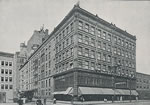 Born in Baltimore in 1855, he came to Newark in 1892 and purchased
the bankrupt firm of Hill & Craig at 147 Market Street, operating
it as L. Bamberger & Co.
Born in Baltimore in 1855, he came to Newark in 1892 and purchased
the bankrupt firm of Hill & Craig at 147 Market Street, operating
it as L. Bamberger & Co.

In 1912, he built a new store which occupied a full city block and
turned it into one of America's greatest and highest-grossing department
stores, providing employment at its peak for 2,800 men and women.
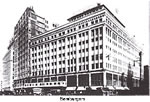
Although he sold the business to R. H. Macy & Co. in 1929, he
remained with his beloved institution as President until his death.
List of His Contributions
He never married, and, as he accumulated his millions, he established
a record of gifts and charitable contributions so great that in
1934, The Newark Museum published a book title "Louis Bamberger:
A Record of His Benefactions to His Community and His Country."
The book was published on the occasion of the 25th Anniversary
of the incorporation of The Newark Museum, of which Louis Bamberger
was one of the incorporators in 1909 along with John Cotton Dana,
and others
The book, assembled by Arthur Frederick Egner, is available for
inspection in the Newark Public Library. Its ID number is: ACV-8494.
Long Activity with Museum
Louis Bamberger had been active with the Museum since its incorporation,
and on February 16, 1926, the Newark Museum, which since its founding
occupied the upper levels of the Newark Public Library, moved into
its own beautiful brass-doored limestone building costing $700,000,
and fully funded by Bamberger.
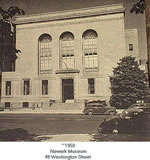
Bamberger had announced the gift in 1923 and had engaged the noted
Chicago architect Jervis Hunt to design it. Bamberger had also been
a donor to the Newark Public Library and was listed as one of its
patrons.
The building of The Newark Museum's first home of its own required
the razing of an old frame mansion that had been the home of Marcus
Ward, governor of New Jersey in 1856, and a leading Newark humanitarian.
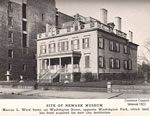
Both Ward and his wife were descendents of original Newark settlers.
To help the Newark Museum off to a good start in its own building,
Bamberger gave the Museum many art, archeological, and scientific
objects from his own personal collection.
Historic Society Broadway Building
Another Newark institution that Bamberger personally funded was
the New Jersey Historical Society. In 1931, he donated a new structure
for the Historical Society at 230 Broadway, enabling the Society
to expand from a smaller downtown Newark location.
In addition to the new building, Bamberger was one of the Historical
Society's greatest benefactors. Among his contributions was his
extensive autograph collection of some 250 historic items. Among
them was a full set of autographs of the signers of the Declaration
of Independence.*(see bottom
of page)
Interest in Other Newark Causes
Among his other Newark nonsectarian benefactions, Bamberger was
one of the most generous contributors to Newark's Community Chest.
He was also involved in numerous other Newark causes, but his innately
shy and retiring nature oftimes prevented them from becoming widely
known.
His Cultural Funding
Music was a strong interest of Bamberger and he endowed music
festivals and scholarships for young people.
He owned radio station WOR since its founding in his store in
1922 and funded numerous programs devoted to home and cultural interests.
In the 1920s, in the early days of radio when most homes did not
yet own radios, he was responsible for placing radio received sets
in Newark public schools, where school children could hear some
of the cultural programs he funded for their benefit.
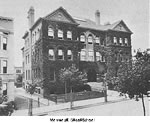
Monmouth Street School, which I attended in the 1920s received one
of those radios. I recall as a student sitting in the school's makeshift
auditorium with students fro other classes to hear the regularly
scheduled radio broadcasts of Walter Damrosch, former conductor
of the Metropolitan Opera and the New York Symphony and composer,
to hear his music appreciation programs. It was before we had the
first radio in our home, and few others in this neighborhood could
afford radios either.
There was also the Bamberger Music Scholarships, which provided
the students of Newark's high schools with an incentive for earnest
effort and development of character.
His Role in the Jewish Community

Bamberger was also considered the leading Jew of Newark's large
Jewish population. At the outset of World War II it was about 60,000.
He and his sister, Caroline Fuld, were both active members of the
Temple B'nai Jeshurun on High Street.
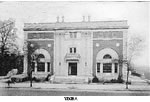
The department store owner was also involved with Newark's YM-YWHA
movement. The 'Y' movement in Newark was the center of Newark's
Jewish social and cultural life in the 1920s, 1930s, and 1940s.
When the 'Y' held a fund-raising drive for a new YM-YWHA building
on May 5, 1920 at the Newark Armory, Bamberger started off the $500,000
drive with a personal contribution of $25,000. His brother-in-law
and business partner, Felix Fuld, also was a substantial contributor
and the three-story Georgian brick building was opened in 1924 at
652 High Street, with its auditorium named "Fuld Hall."
With his brother-in-law and partner, Bamberger also contributed
generously, but usually anonymously, to virtually every Jewish Community
Center erected in New Jersey.
Major Donor to New Beth Israel Hospital
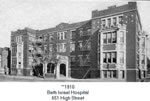
In 1928 Bamberger was a major donor to another Newark Jewish institution
-- the Beth Israel Hospital, originally opening at High and West
Kinney Streets to afford a place of practice for Newark's Jewish
doctors who were turned away at other hospitals.

The High Street facility had grown from 21 beds to 84 beds and was
bursting at the seams, and after a successful fund-raising effort
to which Bamberger was a major donor, the $3.5 million 500-bed facility
was opened at Lyons Avenue and Osborne Terrace.
The hospital has since grown and become a world-renowned medical
facility whose 12-story original Spanish-style building continues
to dominate the South Newark skyline.
Gifts to Some Other Jewish Organizations
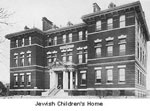
While his moneyed gifts were not always a matter of public record,
these are some of the Jewish organizations that benefited from Bamberger's
largess: The Jewish Theological Seminary ... the American Jewish
Relief Committee ... the Palestine Foundation Fund ... the Emergency
Committee on Jewish Refugees ... the Jewish Children's Home ...
the United Jewish Appeal ... the American Jewish Committee.
How He Dealt with Leadership Offers
In 1930, Bamberger was offered the presidency of the High Street
'Y' building. He declined the offer stating he didn't want to be
on the front line and that instead if they found someone else he
would contribute $25,000 a year for two years toward their salary.
Bamberger, despite his great wealth, was modest and reserved and
not inclined to public speaking or leadership roles in the various
charities that he supported. Whatever leadership roles he did accept
were usually as "Honorary President."
A 1930s vote among readers of the Newark Evening News brought
recognition to Bamberger when he was voted "One of Newark's
Leading Citizens."
Largess to His Employees
Louis Bamberger considered the 2,800 employees of his store as
his extended family, and he was adored by the majority of them.
They would look out for him when he arrived at the store mornings,
entering through the Washington Street entrance.
His usual attire: A homburg to match his light or dark attire,
and striding jauntily swinging a gold-tipped walking stick.
He called his employees co-workers, and in the late 1920s had
established in his store an extension of Rutgers University through
which his employees could take courses in many subjects.
Other features Louis Bamberger provided for his co-workers were
a library, a fully-equipped health department, a social service
department, and a cafeteria. There was also a Bamberger Music Club
for co-workers, and members of the Club were given season tickets
for symphony concerts.
When he sold the store to R. H. Macy in 1929, his final consideration
for his veteran co-workers was a gift of $1 million, divided among
236 employees "for their long and faithful service."
His Greatest Gift
Perhaps Bamberger's greatest philanthropy was the gift, jointly
with his widowed sister, Caroline Bamberger Fuld, of $5 million
($50 million in today's dollars) for the creation and establishment
of The Institute for Advance Study in Princeton.
It was founded as an independent private institute where intellectual
inquiry could be carried out through fundamental research and intellectual
inquiry across a broad range of fields, under favorable circumstances.
Funded in 1930, it helped create a haven for many leading European
scientists fleeing Hitler's Nazi tyrannies.
Albert Einstein was among the first to join the staff of the Institute
and was a permanent faculty member. The institute has since become
the home to more than a dozen Nobel Prize winners either as faculty
or members.
Newark's Reaction to His Death
When Louis Bamberger died in his sleep in March 19441, all of
Newark went into mourning.
As a tribute to this notable Newark citizen, all Newark flags
were at half mast for three days. Newark City Hall was decorated
in mourning colors at the direction of Mayor Vincent J. Murphy.
The store which he had founded, now owned by R. H. Macy &
Co., closed for one day, and its display windows on Market Street
carried photographs of the store's deceased founder.
Perhaps the greatest quality of Louis Bamberger, as one of Newark's
wealthiest citizens, was his philosophy of distributing the bulk
of his wealth while he was still living.
Louis Bamberger was 88 years old when he died.
After-Death Benefactions
His benefactions continued after his death. Among the bequests
in his will, Louis Bamberger left an additional one million dollars
to the Institute for Advance Study, and works of art for the Newark
Museum.
*From
Maureen O'Rourke (Reference
Associate New Jersey Historical Society):
The New Jersey Historical Society no longer has
the full set of autographs of the signers of the Declaration of
Independence. They do have wonderful manuscript groups from him:
The
Autograph Collection, MG 11
Shippen
Family Papers, MG 375
East Jersey Quitrents Accounts Books, MG 217
Goble
Shoe Manufacturers, MG 106
Philip
Kearny, Civil War General, MG 15
|

